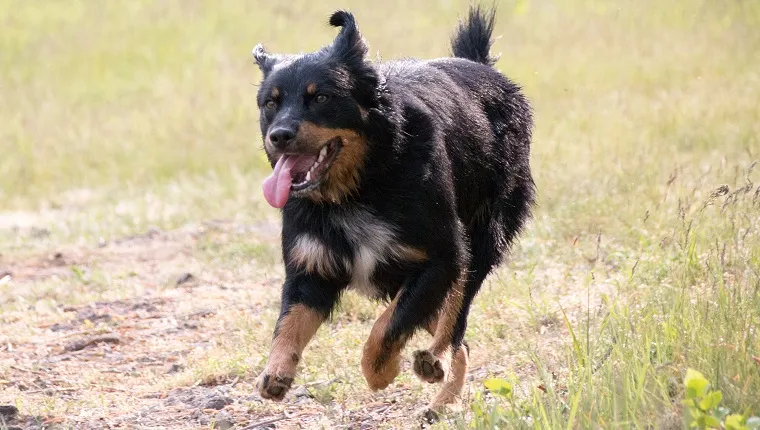Greetings, fellow dog enthusiasts! Today, we embark on an exciting journey into the world of the German Shepherd Rottweiler mix, also affectionately known as the “Shepweiler.” Buckle up as we dive deep into understanding this unique blend of two iconic breeds, combining the strength and intelligence of the German Shepherd with the loyalty and robustness of the Rottweiler.
Origins and History of the Shepweiler
The German Shepherd Rottweiler mix isn’t just a random pairing of two popular dogs—it’s a carefully crafted blend that has gained attention for its desirable traits. Let’s take a closer look at the backgrounds of these parent breeds and how their characteristics come together in the Shepweiler.
The German Shepherd, originating from Germany (as the name suggests), has a rich history as a versatile working dog. Bred originally for herding sheep, this breed quickly gained recognition for its intelligence, loyalty, and impressive work ethic. Over time, German Shepherds have become renowned as police and military dogs, search and rescue heroes, and beloved family pets due to their protective instincts and trainable nature.
On the other paw, the Rottweiler hails from—you guessed it—Rottweil, Germany. These dogs were historically used as cattle drovers, tasked with herding and guarding livestock. Rottweilers are celebrated for their muscular build, unwavering loyalty, and natural guarding abilities. Despite their robust appearance, Rotties are also known for their affectionate and loving demeanor towards their human families.
What Happens When You Mix a German Shepherd with a Rottweiler?
Now, let’s get to the juicy part—the Shepweiler itself! When you combine the German Shepherd’s smarts with the Rottweiler’s strength, you get a hybrid that’s packed with potential. These dogs typically exhibit a blend of their parents’ traits, both in appearance and behavior.
Appearance: Shepweilers often inherit a powerful build from their Rottweiler lineage, coupled with the agility and athletic frame of the German Shepherd. They usually sport a dense, double coat that can vary in color from the classic black and tan of the German Shepherd to the distinct black with rust markings of the Rottweiler. Their ears may flop over (like the German Shepherd’s) or stand erect (like the Rottweiler’s), adding to their unique charm.
Temperament: One of the most appealing aspects of the Shepweiler is its temperament. These hybrids tend to be intelligent, loyal, and protective, making them excellent family pets and guardians. They are known for their strong bonds with their owners and can be wonderfully affectionate companions when properly socialized and trained. However, their protective instincts inherited from both parent breeds mean they require early socialization and consistent training to ensure they become well-rounded adults.
Health Considerations: As with any hybrid breed, potential health issues can arise from both parent breeds. Common concerns for Shepweilers may include hip dysplasia (common in both German Shepherds and Rottweilers), joint problems, and certain genetic predispositions. Regular veterinary check-ups, a balanced diet, and sufficient exercise are crucial for maintaining their health and well-being.
Caring for Your Shepweiler
Now that you’re considering adding a Shepweiler to your family (and who wouldn’t, after reading all this?), it’s important to understand how to care for these magnificent creatures. Here are some essential tips:
Training: Start early and be consistent. Shepweilers are highly intelligent and eager to please, but they can also be strong-willed. Positive reinforcement techniques work best, coupled with firm, gentle guidance.
Exercise: Both German Shepherds and Rottweilers are active breeds, and Shepweilers are no exception. They thrive on regular exercise to maintain their physical and mental well-being. Daily walks, playtime, and mental stimulation are key to preventing boredom and ensuring a happy, healthy dog.
Nutrition: Feed your Shepweiler a high-quality diet appropriate for their age, size, and activity level. Consult with your veterinarian to determine the best food options and feeding schedule for your individual dog.
Socialization: Early and ongoing socialization is crucial for Shepweilers to ensure they grow up to be well-adjusted and confident around people and other animals. Expose them to various environments, experiences, and individuals from a young age.
Conclusion
In conclusion, the German Shepherd Rottweiler mix, or Shepweiler, is a captivating blend of two exceptional breeds known for their intelligence, loyalty, and strength. Whether you’re drawn to their striking appearance, their protective instincts, or their loving nature, Shepweilers have a lot to offer as companions and family pets.
- Best Lusha Alternatives for 2025 - April 19, 2025
- Best Overloop Alternatives for 2025 - April 19, 2025
- Best Snov.io Alternatives for 2025 - April 18, 2025



